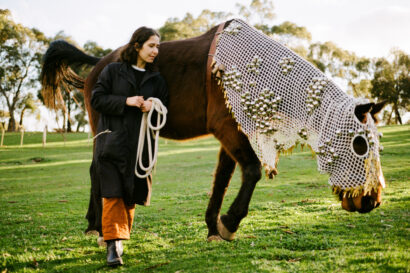Did anyone else notice?
Featured among the international artists appearing at the Perth Festival were two local composers, and they were both women.
Cat Hope’s searing opera Speechless made a profound impact on audiences at its premiere and scores by Rachael Dease were a large part of the success of the daring dance theatre work Sunset (STRUT Dance and Maxine Doyle, with Tura New Music) and the children’s theatre piece A Ghost in My Suitcase (Barking Gecko Theatre).

It went unmentioned – as it should. A woman composer headlining a national festival shouldn’t be exceptional. Yet until very recently it has been. As we celebrate International Women’s Day today it is worth remembering that the playing field has not been even for women in the arts and in many ways they are still playing catch up.
Everything I’ve ever wanted to do would’ve been easier had I
been a boy. But never mind, I never paid much attention to it,
I just marched in and there I was.
These fighting words come from Peggy Glanville-Hicks (1912-1990), arguably the most famous female composer in her lifetime and one of the first Australian women to march into the male-dominated world of composition.
Back then the costs were high: Glanville-Hicks’ colleague Margaret Sutherland was married to a psychiatrist who thought a woman wanting to compose music was a sign of mental illness, while many women had to lie about their gender to be published. Positions on the boards and in the institutions were held by men, who also received the majority of the commissions. In spite of this Sutherland almost single-handedly pioneered modernism in Australian music and in 1938 Glanville-Hicks was the first person to represent Australia at the International Society of Contemporary Music.
Australian women have made a significant contribution to Australian music history, a subject I researched and celebrated in my book Women of Note; the rise of Australian women composers (Fremantle Press 2012). As I pieced together the missing jigsaw pieces of our music history it became startlingly clear that our women composers have substantially shaped our history, often punching above their male contemporaries and often against great odds.
Today Dease, Hope and their female colleagues make up around 27 percent of Australian composers, sound artists and improvising performers. Sadly our concert programs (in any musical genre) don’t reflect anywhere near this statistic. Musicologist Sally Macarthur noted in 2013 that only 11 percent of the works in Australian new art music concerts advertised online featured works by women. And you can scour the West Australian Symphony Orchestra’s 2019 program without finding any female composers represented.
 Fortunately some organisations and individuals are rethinking their approach to inclusive programming and commissioning. ABC Classic has begun to intentionally program more music by women on its airwaves and, as part of International Women’s Day, has scheduled four days of music entirely by women. The station has also released an album titled Women of Note which celebrates 100 years of music by Australian women. This contribution towards a more balanced canon of music is a crucial part of rewriting history and normalising gender diversity for future generations.
Fortunately some organisations and individuals are rethinking their approach to inclusive programming and commissioning. ABC Classic has begun to intentionally program more music by women on its airwaves and, as part of International Women’s Day, has scheduled four days of music entirely by women. The station has also released an album titled Women of Note which celebrates 100 years of music by Australian women. This contribution towards a more balanced canon of music is a crucial part of rewriting history and normalising gender diversity for future generations.
The album includes music by Sutherland, Glanville-Hicks and other trailblazing works including Miriam Hyde’s first Piano Concerto, premiered in 1934 by the composer with the London Philharmonic Orchestra, plus Dulcie Holland’s highly regarded Piano Trio, a work that was unperformed for nearly fifty years before it was unearthed and premiered at the Adelaide Composing Women Festival in 1991.
The album also pays tribute to living composers such as Anne Boyd whose As I Crossed a Bridge of Dreams (1975) was an early precursor of minimalism. Elena Kats-Chernin, arguably Australia’s most popular and best known composer, is represented with her famous Russian Rag while Yuin woman Brenda Gifford brings insights from her Indigenous culture to the Western classical tradition. And composers such as Sally Whitwell, Maria Grenfell, Kate Moore, Nicole Murphy and Olivia Bettina Davies represent the myriad ways in which classical music is developing in the 21st century.
Which brings us back to Cat Hope and Rachael Dease and their fresh, absolutely unique contributions to the Perth Festival. I hope I wasn’t the only one who noticed. I hope curators, directors and commissioners noticed. I hope commentators, creators and the audience noticed. And I hope future generations of gender diverse composers noticed.
– Rosalind Appleby
To celebrate International Women’s Day Seesaw has copies of ABC Classic’s album Women of Note and Appleby’s book Women of Note; the rise of Australian women composers to give away. To enter, email hello@seesawmag.com.au with “Women of note comp” in the subject heading. Competition closes 5pm, March 11.
Pictured top: Soloist Karina Utomo in Cat Hope’s “Speechless”. Photo: Rachael Barrett.
Like what you're reading? Support Seesaw.





